#Tenjin ryu
Link
FIGHTING TECHNIQUES ✅ How To Do SHIHO NAGE in a FIGHT 🤩‼️ Jujutsu, Jujitsu, Aikido, Aikijujutsu
#youtube#youtube shorts#soke anshu#anshu christa jacobson#budo ryu kai#budo ryu ninjutsu#ninja#ninjutsu#ninpo#bujutsu#budo#taijutsu#ninpo taijutsu#budo taijutsu#jujutsu#jujitsu#aikijujutsu#aikido#shiho nage#tenjin ryu jujutsu#martial arts#self defense
1 note
·
View note
Text
Handead Anthem character emojis
I don't think I've seen a compiled list anywhere so, for all ten of us Handead Anthem fans out there I figured I'd put together a list of all the emojis the official Twitter uses for the lads! Now you can list all your favs in a reasonable character limit. :D
Note that this list is not complete, because so far as I can tell the only place they're using these is on the character birthday tweets starting with Ryu's last year. Sorry to Shimon fans, you might be waiting for a bit. The ones before that use multiple emojis and don't follow the same format so I'm not really sure which of the emojis are supposed to represent the character (to use Shimon as an example, his might be 🎤 because by process of elimination it can't be ☀ as that's Mamoru's.)
If you want to use my best estimation for what the missing characters might be, I'll denote the ones that don't have an "official" emoji yet with brackets! I'll edit them out later if I'm proven to be wrong. And fix any formatting errors that doing this on my desktop computer might have caused.
deva
Ko Tenjin: 🌒
Atsuhide Eburi: 🏍
Takakage Kurosaki: 🌹
[Shino Ondomachi: 🐰]
B.U.H.
Rikyo Miyoshi: ☕
Deki Hakushima: 🎼
Tengai Hittsukuri: 🎨
[Kuramu Kamara: ✍️]
Yona
[Raiga Waziki: ⚡]
Yasuto Haruno: 🍏
Nora Mukudu: 🐱
Mamoru Kue: ☀
HIGH-TIDE
Ryu Kamara: 🦈
Manato Ishigaki: 🏄
Zumi Fuchaku: 🌺
[Iru Magari: 🕶]
Alba
Heejun Han: 🍪
[Shimon Guri: 🎤]
[Tatsuki Yongmun: 📸]
Shura Jodo
[Gara Ukai: ☠]
Genjiro Chibana: 🍵
Yuki Minano: 🍑
#handead anthem#ref#please feel free to reblog!#....oh kuramu's birthday is TOMORROW huh#well#i guess i'm gonna figure out really quickly whether my guesswork is right or wrong
4 notes
·
View notes
Text
Kodomo yose. Aki fuyu
New item:
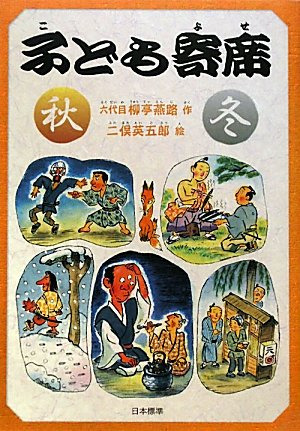
Shelf: 913.7 RYU 2 (@ tadoku section)
Kodomo yose. Aki fuyu.
by Rokudaime Ryūtei Enji ; illustrations by Futamata Eigorō.
Tōkyō : Nihon Hyōjun, 2010.
ISBN: 9784820804444
117 pages : illustrations ; 22 cm.
(Shirīzu hon no chikara).
Previously published by Kozue in 1975.
Text in Japanese, furigana on all kanji chracters.

This book is suitable for tadoku, extensive reading for learners of Japanese-language. Please find details about tadoku and our reading night event on our tadoku web page.
Table of contents:
[Irekomi] Yose tte nan darō : yōkoso, "kodomo yose" e
Hirabayashi
Ōji no kitsune
Meguro no sanma
[Nakairi] Rakugo to nagaya
Toki soba
Dakudaku
Zappai
Sokotsu nagaya
Bakemono-zukai
Hatsu Tenjin
[Uchidashi] Rakugo no tanoshimikata / Katsura Bunga.
0 notes
Text
The Harada Dojo where Kondo Isami first learned the sword
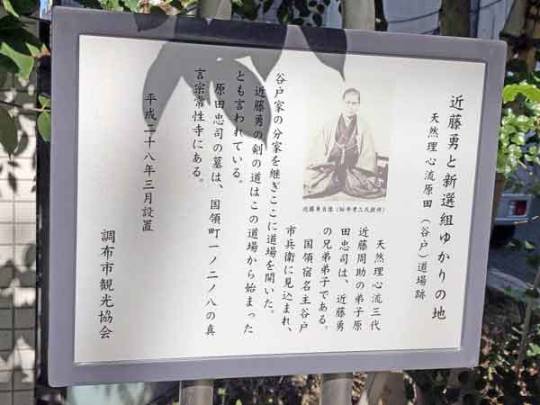
The Harada Dojo is a dojo in Chofu City, where it is said that Kondo Isami learned the Tennen Rishin-ryu for the first time .
It is now an apartment, and there is an information board about Kondo Isami and the dojo next to it.
This post will introduce the remains of the Harada Dojo, which can be said to be the catalyst for the existence of "Kondo Isami".
Directions
Address: 1-30 Kokuryocho, Chofu City
How to get there: 5 minutes walk from Fuda Station on the Keio Line
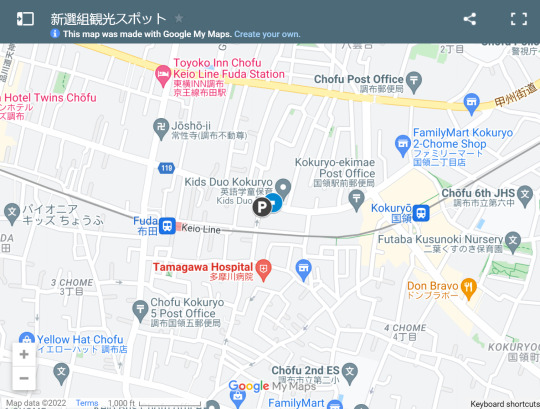
Map of Harada Dojo Ruins
The ruins of the Harada Dojo where Kondo Isami learned the sword for the first time
Information board at the place where Kondo Isami learned the sword

Harada Tadashi Dojo Ruins
Harada Tadashi opened a Tennen Rishin-ryu dojo in a building that was previously the Kokuryo Inn.
According to one theory, Kondo Isami went to this dojo to learn the Tennen Rishin-ryu.
It is also said that Harada Tadashi saw talent in Kondo Isami and brought him to Kondo Shusuke (who later became the adoptive father of Kondo Isami) .
After losing the battle of Toba-Fushimi, the Shinsengumi changed their name to Koyo Chinbutai and went to Koshu (Yamanashi), passing through the Koshu Kaido road in front of this dojo.
At this time, there is an anecdote that Kondo Isami stopped by at the Harada Dojo to greet his former teacher.
Harada Dojo Site Information Board Location
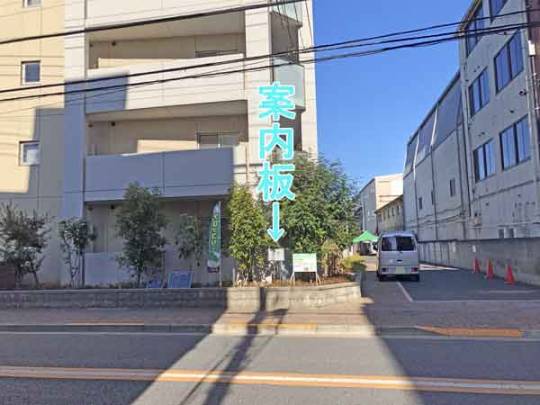
The information board for the remains of the Harada Dojo is in an inconspicuous place
It is about a 5-minute walk from Fuda Station on the Keio Line .
In front of an apartment called Fermier, it doesn't stand out, so you can overlook it easily.
It was lined up with the signboard of "Tanito Farm".
Next to the condominium is the road to Tanito Farm, and next to it is a children's English school called Kids Duo.

The scenery opposite of the Harada Dojo ruins
There is a "Shinju" and a chicken specialty store diagonally opposite.
Who was Harada Tadashi who taught Kondo Isami the sword?
Harada Tadashi was a disciple of the Tennen Rishin-ryu and a student of Kondo Shusuke. He was an assistant instructor for Kondo Shusuke at the Shieikan.
The Kojima family in Machida also recorded that Harada Tadashi often arrived for practice before Kondo Isami arrived.
The dojo used to be the Kokuryo Inn, owned by a branch of the Tanito family which Harada Tadashi belonged to.
Kondo Isami came here, and Harada Tadashi discovered his talent and brought him to Kondo Shusuke.
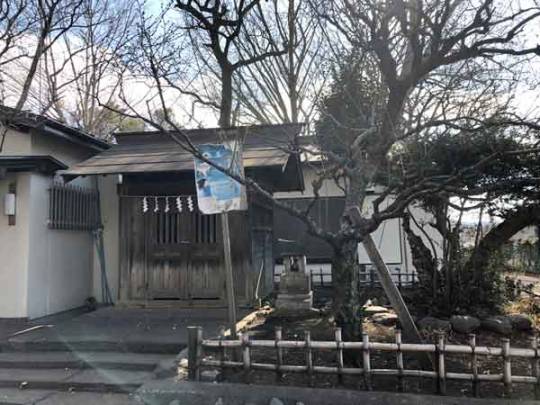
Near the Tenjin Shrine in Fuchu, where there was an outdoor tournament to announce Kondo Isami's succession as the master of the Tennen Rishin-ryu
Later, when Kondo Isami held an outdoor tournament to announce his succession as the master of the Tennen Rishin-ryu, Harada Tadashi participated in the main tent as a metsuke (a role that observed and reported battle movements).
In the main team were Kondo Isami with the role of commander, Okita Rintaro (the husband of Okita Souji's sister) as bugyō (military commisioner), Okita Souji in the role of taiko drums, and Inoue Genzaburo in the role of kane gongs.
Hijikata Toshizo and Sannan Keisuke were in the Red Team and were fighting against the White Team led by Sato Hikogoro.
As a high-ranking disciple of the Shieikan, and as an assistant instructor to the previous master, Kondo Shusuke, it seems that he had crossed swords not only with Kondo Isami, but also with the other members who would later become the Shinsengumi.
Harada Tadashi died in Meiji 26, and his grave is located in the graveyard of the Tanito family at Jyosei-ji Temple (1-2-8, Kokuryo-cho, Chofu City) near the site of the dojo.
9 notes
·
View notes
Note
I have No Idea what Handead Anthem is but I'd love to learn about it! Feel free to dump info abt it through this ask :]]
so handead is an audio project by k4 company ! its basically half dead zombies making edm music
so uhh w the story the ppl who r fully alive ( alivers ) r brainwashed by the government to work 15 hours a day , and they arent able to do the things they want , or follow their dreams and stuff ( basically their entire lives are centered around work )
so handead are half alive and half dead ! theres 3 ways to become handead , you can either take a dead injection , be born handead ( all of the heads, leaders of the teams are born handead ) , or get bitten by someone who was born handead. being handead is the only way to combat the ' deadness ' of being fully alive, so to turn more ppl into handead ( to help more ppl find happiness ) a few handead join together to form dead&alive ( daa ). the music comes in as to convince more ppl to join , they hold concerts and lives and convince ppl to join thru their music
so there r currently 6 teams , each from a diff branch ( other than alba and shura dojo ) which r
deva : fukuoka branch , their head ( leader ) is tenjin ko
HIGH-TIDE : okinawa branch , their head is kamara ryu
B.U.H. : hiroshima headquarters , their head is miyoshi rikyo
yona : kochi branch , their head is waziki raiga
alba : part of DAD ( dead and dominate ) in korea , which im pretty sure is just koreas ver of daa ? , their head is han heejun
and shura dojo : the three of them are all ex-daa members ( since they're not offically part of the daa , i dont think they have a head , and all three of them are handead from birth , while 2 members r ex heads )
agh im sorry if this is kinda confusing im not sure how to say stuff :(
#that was probably .. more than it needed to be#but its rlly a great series <3#🧪 ; handead anthem#pea talks
6 notes
·
View notes
Photo
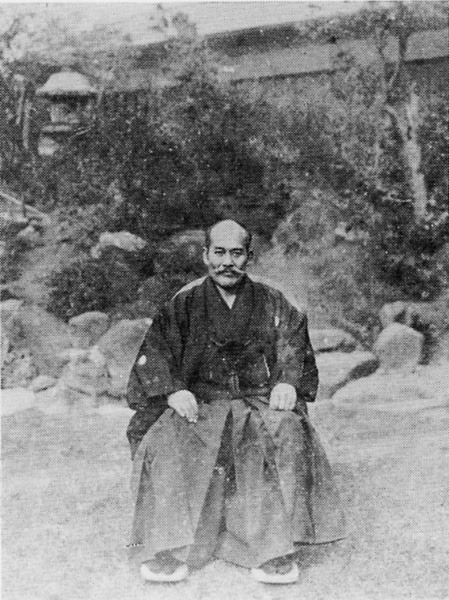
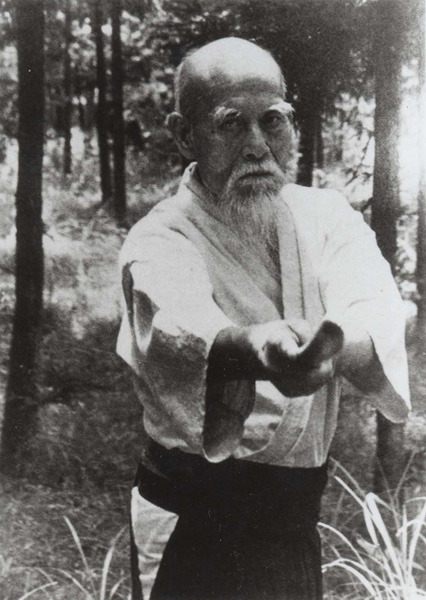

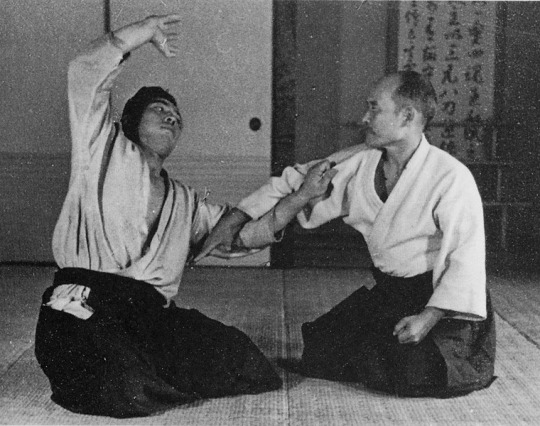
The Aikido founder. Born in Tanabe, Wakayama Prefecture, he studied Tenjin shinyo ryu and other ancient styles of jiu-jitsu at a young age.He met Takeda Sokaku,the Master Daito ryu Aiki jujutsu, and became his disciple.
After that, he opened a dojo in Tokyo and started spreading "Aikido".He taught Aikido energetically all over the country throughout his life, and became a respected by all Aikidoka. Passed away in 1969.
19 notes
·
View notes
Text
Guide to GARO: Pachinko 10: CR Another Garo Honoo no Kokuin
The first and so far only machine based on the anime series. The normal 2D characters are here 3D models mini characters, but serve the same role. Animation style for armour scenes varies a little depending on which form of the armour is being used. Kokuin Garo scenes are done in the animes style, while ones with the armour in its normal form mostly use the live action style.
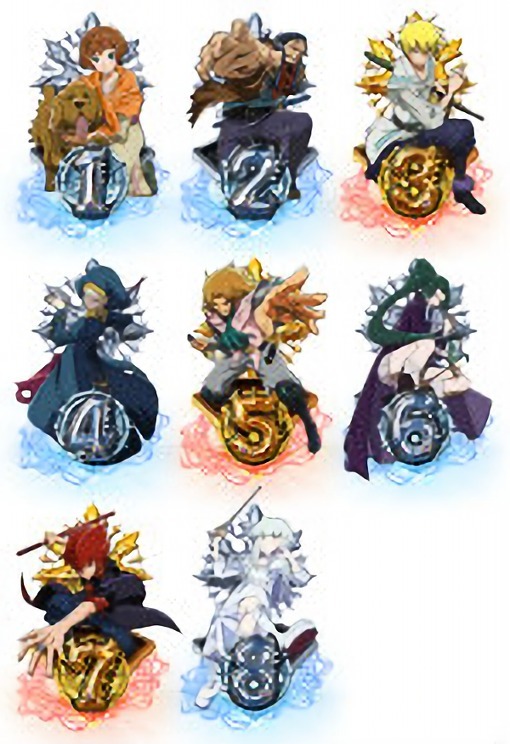
The Mini character scenes are Leon chasing Marcello, Alfonso training with Rafael, Ema escaping a dimension trap and Germán pursuing ladies.
Original battles for Kokuin Garo are battles with enemies faced in the series, On-bra, Mandula and Metacrim.
Ougon Garo battles are all with powerful enemies Léon didn't face in the series, Grand Magis, Cho Maju Soko Octavia, Blood Moon. Then two specials.
W Garo Vs Gurondo
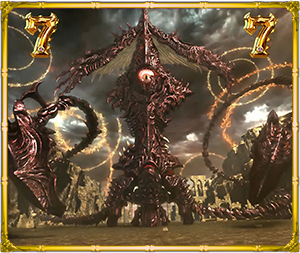
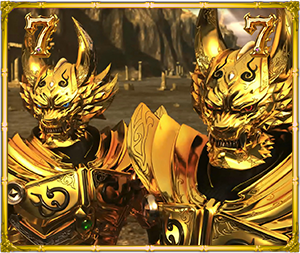
Soryu Jushin Garo Vs Geraiga
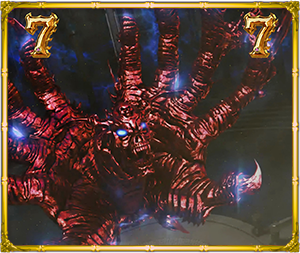
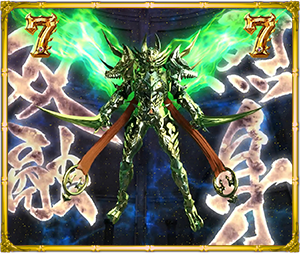
Story scenes cover a climactic battle for each of the main 4 characters from throughout the series. In at least one case some additional footage is included.
One scene does have the actual debut of Gaia's Madou Horse, Tenjin. A few scenes feature Goten.

Makai Battle Mode starts with two variants, one with Mendoza, the other with Anima Mendoza. I don't believe I have ever seen the ending, but the goal seems to simply be defeating all the enemies.. Gaia, Zoro and Zaruba are allies.
The enemy list includes a lot powerful enemies from specials and other machines; Okami Genryu, Sonicuras, Kokuryu, Ankoku Kishi Zex, Metacrim, Toriga, Kuruzu, Grau Ryu, Demon Teddy, Nero, Andragao, Ring, Bouqueria, Makairyu, Dai Goryu, Cho Maju Soko Octavia, Grand Magus and Blood Moon.
2 notes
·
View notes
Text
THE ORIGIN OF NAGE NO WAZA
THE ORIGIN OF NAGE NO WAZA
TENJIN SHINYO RYU JUJUTSU
View On WordPress
0 notes
Text
Ninjutsu...
The student that studies with the conscience of the divine, will be allowed to perceive the deepest secrets of the arts, as perception is a matter of perspective.
.
When learning the deepest secrets, one must walk down the path of Koden (古伝; Old Transmission), receive the Kuden (口伝; Verbal Transmission), understand the Hiden (秘伝; Secret Transmission), feel the Shinden (神伝; Divine Transmission) while studying the Densho (伝書; Written Transmission).
.
So just because someone has bought a scroll, or has a scroll, does not mean that they know the art or understand the secrets. The scrolls are just a physical symbol of the ryuha.
.
Here at the Budo Ryu Kai one has to dedicate themselves to the study of Ninjutsu and Bujutsu through the practice of the seven warrior traditions:
.
Koka Ryu Kempo (甲賀流拳法)
Tenjin Ryū Jujutsu (天神流柔術)
Tomo Ryu Shinobijutsu (戸猛流忍術)
Eishin-ryū Iaijutsu (英信流居合術)
Koto Ryu Koppojutsu (虎倒流骨法術)
Gyokko-Ryū Kosshijutsu (玉虎流骨指術)
Togakure-ryū Ninpo Taijutsu (戸隠流忍法体術)
.
Through the training of the nana musha-den, as well as the goho-no-keiko, one then starts to understand themselves and find their way through the understanding of Budo Ryu Ninjutsu.
1 note
·
View note
Link
Martial Arts
A demonstration of classical Ju Jutsu from the annual Meiji Shrine martial arts celebration, in Tokyo. Take note of the approach, it's all close range and against grabs. Realise that much of this is based around preventing someone grabbing your sword or preventing someone from drawing theirs. Pointedly, there is little rolling around on the floor - thought of as the signature for Ju Jitsu these days.
Lastly something that even surprised me - kicking the guy when he's down ! Can't say I've seen this before in over classical Ju Jutsu style demonstrations.
#martial arts#japanese martial arts#martial arts history#ju jitsu#classical martial arts#traditional martial arts#Japan#meiji jingu#budoblr#budo#bujitsu
0 notes
Text
100 Years of Mastery: Golden Kamuy and Judo
Golden Kamuy digs deep into the history and culture of 1900s Japan, showing us life in snowy Hokkaido both in its growing cities and the Ainu's wilderness homes. We've learned all about Ainu food, survival techniques, and even the series' tense political climate--and while we're all wrapped up in the conspiracies and jagged alliances, it's easy to forget that Golden Kamuy is also a violent, rough-and-tumble action-adventure.
In fact, one thing that's surprised me from the get-go (but shouldn't have, really) is how much detail and thought is put into Golden Kamuy's martial arts, and how they and the series' action are informed by the state of martial arts in 1900s Japan. This is covered on multiple fronts with a variety of characters, but let's start with one of the best--Ushiyama the Undefeated and his judo!
Judo, meaning "the Gentle Way," was invented in 1882 by Jigoro Kano, a Tenjin Shin'yo-ryu jujutsu practitioner who was blessed with a great mind and technique but cursed with a small body. Seeking a way to defeat larger, stronger opponents, he collected throwing and submission techniques from multiple jujutsu schools that he later codified into the Go Kyo no Waza, or Five Sets of Techniques. These throws, chokes, armbars, and leg locks became the curriculum of a new fighting system--instead of being a list of physical techniques (jutsu), judo was intended to be an all-encompassing philosophy or way (do), separating it from its origins in jujutsu.
Judo places a heavy emphasis on randori, free practice that focuses on practical application of techniques. It's one thing to practice forms and imagine throwing a human body, and it's another to internalize judo's philosophy of "maximum efficiency, minimum effort." The idea of leverage and technique over strength meant that a judo practitioner would conserve energy and use the smartest possible technique at the right time, instead of muscling through techniques to force a submission or throw. This also means that like in jujutsu (and later aikido), a judo practitioner has to know how to fall, and how to safely receive techniques so their partner can practice with them.
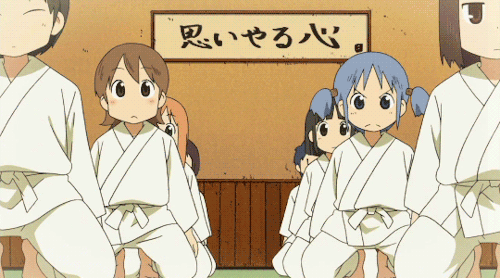
Not like this.
In the time Golden Kamuy takes place, judo is a refreshing new style, almost a fad, that combines the tradition and discipline of martial arts with the excitement and camaraderie of sports. With the Meiji Era's sword ban leading to the development of kendo, it was jujutsu's turn to evolve into a modern style, and competitive judo spread throughout Japan and further, with Kano visiting the United States and Europe. By 1900, changes were made to the competitive judo ruleset prohibiting certain joint locks to create a safer sport, and in 1911 it was inducted into Japan's educational system.
Today, judo is one of the world's most notable, popular martial sports, with schools across the globe. Judo has been an Olympic event since 1964, where it saw a resurgence in worldwide popularity--there was an even an episode of Happy Days where Arnold, played by Pat Morita, taught the kids judo. Martial arts themselves have come full-circle, with jujutsu going through yet another evolution to become Brazilian jiu-jitsu, leading to the modern definition of mixed martial arts. (For real, when you're done reading this go watch Fighting in the Age of Loneliness.)
In the 1964 Tokyo Olympics, Japan took Gold in the Light, Middle, and Heavyweight divisions, but the Netherlands' Anton Geesink took the Open Division Gold
Golden Kamuy mainly uses judo through Ushiyama the Undefeated, an escaped Abashiri convict who's been training for ten years without a single loss. The man already sounds like a monster on that alone, but then you can add the whole seducing-his-master's-wife-and-killing-his-master thing for flavor. Hell, when Shiraishi accidentally runs into him in episode 7, Ushiyama does (kind of an) okuri-ashi-harai on a horse:
And a real one for comparison--watch Hedvig Karakas in blue:
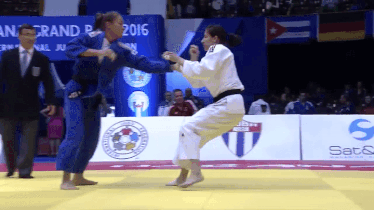
Episode 11 features Sugimoto's group running into Ushiyama again, and Sugimoto takes note of Ushiyama's ears--these are called cauliflower ears, and are a condition caused by blood clots (or other fluid) collecting in the ears' cartilage from blunt trauma. This is most common in combat sports (like judo!) or in contact sports where the ears are unprotected, like rugby.
Here's UFC legend Randy Couture's cauliflower ear, which got made fun of in The Expendables:
Moments after this, Ushiyama shakes Sugimoto's hand, and the two of them immediately get into a standing grapple, or kumi kate. Ideally, you're holding your opponent's sleeve with one hand and their lapel with the other. From here, you start trying to apply kuzushi, or unbalancing techniques, to get into a favorable position to perform a throw. Sugimoto notices that Ushiyama's center of gravity is incredibly low (he feels like it's "below the ground"), so trying to use a throw on Ushiyama would be super difficult and dangerous.
After a filling dinner and a lot of Sapporo beer, everything goes insane and Sugimoto actually has to fight Ushiyama the Undefeated back at the hotel. It's just as ludicrous and insurmountable a task as it sounds, but let's go through it technique-by-technique and watch Sugimoto totally almost die.
First things first: Ushiyama and Sugimoto lock up again, and Ushiyama just slams Sugimoto through a wall.
Sugimoto steps in and goes for what's probably judo's most recognizable technique, the shoulder throw called seoi nage.
And a real seoi nage for comparison:
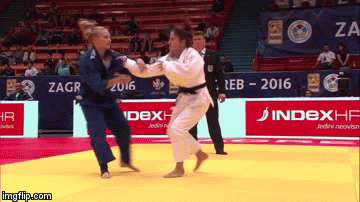
But Ushiyama, being the UNDEFEATED FREAK THAT HE IS, sticks his hand out in the middle of the throw to readjust his balance, and puts his feet up against (and through) the wall to prevent the throw.
And then... yeah, I can't really call this a judo technique as much as it's just the first half of a straight-up Power Bomb (but for the sake of this article, we'll say Ushiyama's doing a modified ushiro goshi, or back drop). Bye, Sugimoto.
To compare, here's a real ushiro goshi:
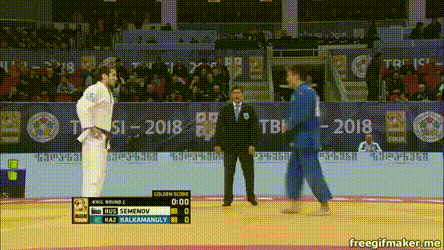
Sugimoto bravely tries to apply a juji gatame armbar on the still-not-fallen Ushiyama, but gets wrenched off the ground and slammed into the ceiling like he weighs nothing. Sugimoto then falls through a trapdoor and that brings this awesome fight to an end.
We don't see much of Ushiyama's judo until the second-season OP, where he does what looks like an uchimata (or a harai goshi?) on a freaking bear:

And then a real uchimata now:
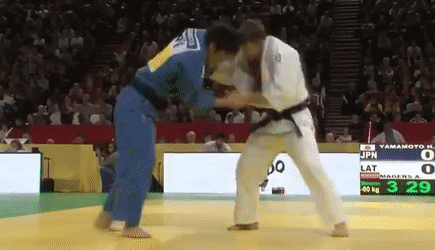
And while Ushiyama hasn't yet had as intricate a fight as the one in episode 11, in episode 21 we got to see an accurate depiction of the technique hadaka jime (aka a rear naked choke) by blind marksman Toni Anji. Notice how he's grabbing hold of his shirt to lock the choke, like how a jujutsu or judo practitioner would grab their gi.
While fighting Toni Anji, Sugimoto goes for another seoi nage, this time tucking his chin to try and drop Anji on his head. It's a very short sequence, but it's safe to say that Sugimoto's regular go-to technique is the seoi nage.
With season 2 of Golden Kamuy over, we're going to have to wait to see if there will be more judo on display. In the meantime, I'll be doing another article soon, this time talking about the history of karate and kenpo as used by the Japanese military, how it's portrayed in Golden Kamuy, and the history of kenjutsu and kendo, specifically Hijikata Toshizou's "Shinsengumi kenjutsu," reportedly derived from Kondo Isami's Tennen Rishin-ryu.
What have you found interesting in Golden Kamuy's martial arts? Have you ever trained in judo or jujutsu? You think you could take Ushiyama? Sound off in the comments and let us know!
-----
Nate Ming is the Features Editor for Crunchyroll News and creator of the long-running Fanart Friday column. You can follow him on Twitter at @NateMing. His martial arts webcomic, Shaw City Strikers, launches January 15, 2019.
0 notes
Text
The women of Kondo Isami: Tsuyu, Miyuki, Takashi, Komano
Matsui Tune, the wife of Kondo Isamu, was born in 1858 as the eldest daughter of Matsui Yasugoro, a shogunate retainer. In the first year of Man'en, at the age of 23, she entered into an arranged marriage with Isamu Kondo, and two years later gave birth to their first daughter, Tama. According to Kondo, "I had arranged marriages with many beautiful women, but Tsune was the most ill-bred of them all. The disciples of Kondo said that he chose an ugly woman to be his wife because he would not be able to devote himself to his training with a beautiful woman. When Isamu Kondo went to Kyoto as a ronin with his students, Tsune looked after Shusai Kondo, Isamu Kondo's foster father, and stayed with his daughter Tama at the home of Miyagawa Otogoro (Isamu's elder brother), Isamu Kondo's family, after his execution at Itabashi in 1871. When Tama was 15 years old, he married Otogoro's second son, Yugoro, and they had their first son, Hisataro. (Kyutaro later joined the army during the Russo-Japanese War and died of illness.) ) Tune had promised Otogoro Miyagawa that she would inherit the Kondo family by adopting Yugoro as her son-in-law, and in exchange for handing over the dojo of Shizen Rishin-ryu, she would receive a share of the Miyagawa family's land. When Kondo returned to Edo after his defeat in the Battle of Toba-Fushimi, he said he was looking forward to seeing his wife and children on the ship and had a silver ring as a souvenir for Tsune. Kondo, who had many concubines in Kyoto, was also kind to his wife. In Kyoto, Kondo, on the other hand, was able to make a lot of money as the head of the Shinsengumi, and he began to fish for beautiful prostitutes and courtesans in Kyoto and Osaka and began to surround himself with them. First, there was Koganedayu, a prostitute at Shimabara Kizuya, who was one of the five most beautiful women in Kyoto, aged 23, and Kondo's favorite. Next was a geiko named Ueno of Kamishichiken. She was not so beautiful, but she was not registered as a geisha and was allowed to play at the home of Ueno's father. Ueno's father was the head of a large family in Kyoto and lived on Gozen-dori in Tenjin. The most famous of Isamu Kondo's mistresses (played by Yuka in the historical drama) was Miyukitayu, a tall, beautiful woman born in Kanazawa. At the age of 14, he went to work at a teahouse in Sambongi, Kyoto, and moved to Shimabara at the age of 16. At the age of 18, he became a tayu (a courtesan) and took the name "Waka-tayu" (a young tayu), and became well known for his beauty. He was immediately taken in by a servant and kept in a house near Ikedaya in Kyoto, where he was arrested by the Shinsengumi and became acquainted with Kondo. He then returned to Shimabara and went up to the tatami room under the name of "Miyukitayu," but Isamu Kondo made a move to Oriya in Osaka's Shinmachi district, and he was then taken in as a fugitive and kept in a rest house at the bottom of the Kizuya Bridge in Kizuya, Awakegai, Kyoto. Miyukitayu lived there with his sister, Otaka, but while Miyukitayu was away for treatment for rheumatism, Kondo had relations with her. When Miyukitayu realized this, Kondo gave him 200 ryo in compensation, and he withdrew and bought a teahouse in Shimabara. (One theory is that he died of illness.) His younger sister, Otaka, was a geisha at a teahouse in the Sonezaki-shinchi district of Osaka under the name of "Gokotayu," but after her sister Miyukitayu was married off to Kondo, Otaka was also rejected by him and lived with her at a rest house down the Kizuya Bridge in Kizumigai, Kyoto. After Kondo and the Shinsengumi left for Edo, Otaka was taken care of by Otaka and his sister Miyukitayu at their teahouse. However, the teahouse did not do well and closed its doors, so Otaka left Isamu with his sister and went to work at the port of Kobe. He disappeared for some time, but in 1882, he suddenly received a letter from his sister, Miyukitayu, saying that she was working in Singapore and had made some money. However, Oyagi left home after a dispute with Miyukitayu and became a geisha in Bakan, where she was favored by government officials such as Hirobumi Ito and Kaoru Inoue. After returning to Japan, Otaka sought out and reunited with Isamu Oyagi, who reportedly married a Korean trader and had three children. Finally, there was another woman who gave birth to Isamu Kondo's child. Her name was Komano, and she was a geiko in Sanbongi, Kyoto. After Kondo was executed at the Itabashi execution site in Keio 4 and his head was displayed at Sanjo Kawara in Kyoto, Komano gave money to a Tsuji lecturer to give a speech about Kondo's achievements in Kyoto and a memorial performance. When he returned to Kyoto after the Meiji Restoration, Miyuki-no-Tayu visited Komano in Sanbongi out of concern for Kondo. According to the story told at the time, Kondo's orphaned boy "was sent to a foster home until he was five years old, and was raised by the family until he was seven, when someone recommended that he be sent to Tofukuji Temple to become a disciple of the Buddha. It is said that the boy grew up to become a splendid monk and mourned for the repose of Kondo Isamu's soul.
3 notes
·
View notes
Photo

From the upper right to the left: Yamamoto Kunio (man's name). Saitama Bugei-cho (Directory of Martial Arts in Saitama). In red below (from the right): Sakakibara Kenkichi (a famous swordsman of the Kashima Shinden Jikishinkage-ryu kenjutsu). Iso Yoshito (perhaps read as Gichin, probably a leading exponent of Tenjin Shin'yo-ryu jujutsu). Source:http://sakitama-s.com/books/classification/history/entry_2203/ Thank's to Tobias Kiefl, Chris Covington, Daria Liko #jikishinkageryu #inazuma #kenjutsu #kashimashindenjikishinkageryu #naginata #naginatajutsu #koryu #sakakibarakenkichi https://www.instagram.com/p/Bo98Yubj_aD/?utm_source=ig_tumblr_share&igshid=nq7gcnkvkwen
#jikishinkageryu#inazuma#kenjutsu#kashimashindenjikishinkageryu#naginata#naginatajutsu#koryu#sakakibarakenkichi
0 notes
Text
Kurin Iaito (blunt edge) - Hiranami - by NineCircles
From the Shinto creation myths of Japan, through a myriad of legends of hideous sea monsters, to nationwide festivals giving thanks for the bounty of the ocean, the sea is intrinsically bound to Japanese culture and mythology.
The Hiranami model's Higo style hilt fittings depict a beautifully sculpted wave design, complemented by a flowing crescent Tsuba in blackend steel.
Kurin produce professional quality Iaido swords for the international market. The very purpose of an Iaito is to emulate a real sword as closely as possible, whilst eliminating the danger factor involved when practicing with a 'live' blade. These unique stainless steel Iaito fulfil that function to perfection.
Blade geometry, weight, balance, material flex and performance are all near identical to the high quality Shinken Kurin produce for advanced Iaido practice, making these Iaito the perfect option for Seitei and Koryu Iai practice.
These swords are strictly for use outside of Japan where the law proscribes the use of the superior stainless steel materials for the production of unregistered blades.
Features of these models include:
Iaido Blade - blades are slimmed down and have a full Hi to reduce overall weight and improve balance.
430 Stainless Steel - the ideal balance between strength and flexibilty, this tempered 430 stainless steel behaves near identically to the high carbon steel found in Kurin's production Shinken and is not at risk of stress factors sometimes seen in alloy Iaito blades.
Mirror Polish - a huge advantage over Japanese Iaito, these blades are polished to a mirror finish. This eliminates the risk of chrome fatigue and offers the chance to polish out damage caused by accidental contact with the floor or other blades.
Silver Kanagu - silver fittings in classic Japanese designs bring an additional touch of class to complete the package.
These swords do not include a stand.
The Kurin
stainless steel Iaito are a revolution in Iaito manufacture, combining the fluid grace and style of Japanese alloy Iaito, with the strength and durability of stainless steel. Very close in shape and feel to a Shinken (genuine sharp steel sword), but with a dulled edge for safe Iaido practice, these swords are great value for money and will last a lifetime of practice.
Aiki-Jujutsu and its Social Background
The next two and a half centuries (Tokugawa period) were relatively peaceful for Japan. Though they continued to practice, the Samurai as a class, saw little combat, and refined the various martial arts of Kenjutsu, Iai jutsu, Bajutsu, and forms of Jujutsu. Ju is a Chinese word meaning pliable, harmonious, adaptable or yielding, Jutsu means technique. As a collective term applied to all fighting forms, Jujutsu came into existence long after the forms it describes originated. Jujutsu's golden age extended from the late 17th century to the mid 19th century. As the martial arts and all Japanese culture became strongly influenced by Buddhist concepts, the fighting arts were transformed from combat techniques (Bugei) into ways (Budo), inculcating self-discipline, self-perfection and philosophy. The dimensions of the martial arts expanded beyond the simple objective of killing an enemy to include many aspects of everyday living. Particularly after the decline of the Samurai class, the martial techniques became martial ways and great emphasis was placed upon the study of Budo as a means of generating the moral strength necessary to build a strong and vital society. At the time, Aikido was known by many names, and remained an exclusively Samurai practice handed down within the Takeda family until Japan emerged from isolation in the Meiji period. The Meiji Revolution (1868) brought not only the return of Imperial supremacy, but also a westernised cultural, political and economic way of life to Japan. The Bushi, as a class, virtually disappeared under a new constitution that proclaimed all classes equal, but the essence of Bushido, cultivated for many centuries, continued to play an important part in the daily lives of the Japanese. Budo, being less combative and more concerned with spiritual discipline by which one elevates oneself mentally and physically, was more attractive to the common people of every social strata. Accordingly, Kenjutsu became Kendo, Iai jutsu became Iaido, Jojutsu became Jodo and Jujutsu became Judo. O-Sensei Morihei Ueshiba: The Founder of Modern Aikido As a young man, Morihei Ueshiba (born 14th December 1883) had an unusual interest in the martial arts, philosophy and religion. The environment of his youth, one of religious discipline and tradition, had an enormous effect on the course of his later life. In the year 1898, Ueshiba left his home village outside Osaka and travelled to Tokyo, seeking instruction in the martial arts. He actively investigated dozens of arts, but was eventually drawn to specialize in three: the sword style known as Yagyu Shin-Kageryu, the staff style known as Hozoin-ryu and Tenjin Shinyo Jujutsu. The Russo-Japanese War (1904) provided Ueshiba with a real situation to develop himself mentally and physically, in accord with the principles he had learned during his martial arts training. Ueshiba the soldier, spent most of the war years in the harsh climate of Northern Manchuria and by the end of the war, his health had deteriorated considerably. With characteristic vigour, he regained his vitality by the way of long hours spent in outdoor labour. Soon, Ueshiba was engaged by the government to lead a group of immigrants to Hokkaido (the Northern Island of Japan). Another adventurous young man also made the move to Hokkaido, his name was Sokaku Takeda, head of the Takeda family. Ueshiba and Takeda met in 1905 and Ueshiba began his study of Daito Ryu Aiki-Jujutsu under Takeda Sensei. In addition, he continued to practice the other arts he had learned in Tokyo, particularly Kenjutsu and Jojutsu.
#Aikido#Aikido Self Defence instruction#martial arts#japan#karate#weapons#MMA#Self Defence#Fitness#swords knives
0 notes
Photo

福岡着でございます。 本日ライブですー! 2018.5.19(土) Hot & Cool presents 「Oldies but Goodies」 Music Bar Shangri-la 開場 19:00 / 開演 19:30 charge 2000円(別途1ドリンクオーダー) Ayumi-Ryu 西田祥恵 (from 長崎) 坂本勝則 いま今津 てかね、ばり寒か! 長崎が蒸し暑かっただけなんやけど。 今からリハーサルしまーす! (Tenjin Station)
0 notes
Text
Beyond Judo
Judo was created as a physical, mental and moral discipline. Judo is not only by enemy but also use for self defence.This kind of martial throwing or takedown an arts was started in Japan and created by a man named Jigoro Kano who is a master in Tenjin-shinyo-ryu jujitsu.
This ancient form into a sports which is know as Kodokan Judo. This self defence forms and integrated the best sports was use in education to discipline our physical body and mental thinking.This sports is for women and men, even your children can be because this sports teach us to be calm and to have some respect.
Benefits of Judo
1.It teaches you the value of hard work
When you start out you are getting thrown and submitted at will. But you will start to see that as you put more time into your practice, it takes you longer to lose, and you lose less and less. And then you put more time in you will eventually win against those that you were unable to beat before. And by that time, you are now the one throwing and submitting guys in class. Judo teaches you the value of hard work, because you actually get to see the fruits of your labor every time you spar. Your progress can be seen; it’s tangible
2.It teaches to fight fears
The fear of being physically hurt is a strong emotion that holds many people back from many of life’s more enjoyable activities. Judo does not sugarcoat the fact that they are combative sports pain is part of the game. And while injuries do happen, precautions are taken to make sure that you are as safe as possible. The people that stay with judo are eventually able to face their fears of being hurt, by forcing themselves to take the pain and becoming resistant to their fear of pain as a result.
3.It toughens you physically
Practicing judo is going to hurt and it is going to be painful . As far as physical pain goes, judo is one of the roughest sports out there. The sport places a huge emphasis on safety, but you are going to get thrown to the ground,a lot . That is just the how it is. But as you get thrown more often, your body starts to toughen up and absorb the pain a lot better. Then, it won’t hurt as much.
4.
It builds mental toughness
Mental toughness is a big reason why I continue with judo. This sports teach you to fight through discomfort and pain. It teaches you to fight back when you are backed against the wall. It teaches you that you should not be afraid to fight someone bigger or more skilled than you. “being thrown around makes you physically tough, but Judo also builds mental toughness; knowing you can go up against a guy twice your size “
0 notes